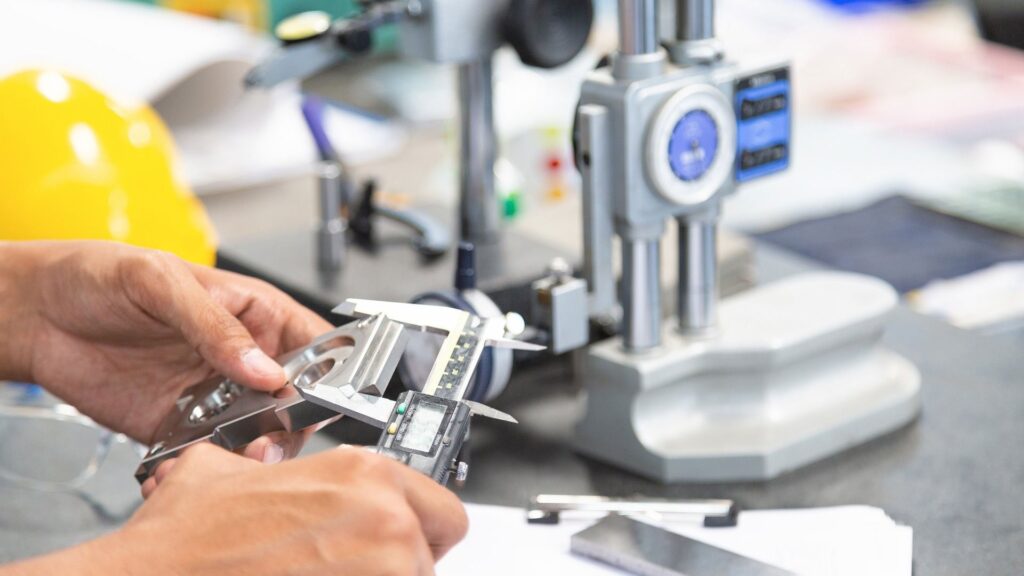
Computer Aided Tool & Die Design Engineer
4.8 out of 5 based on 8363 reviews.
#Program
About Program
QP Name: Computer Aided Tool & Die Design Engineer
QP Code: CSC/Q
QP Version: 1.0
NSQF Level: 6
Model Curriculum Version: 1.0
A Computer-Aided Tool & Die Design Engineer specializes in designing, developing, and optimizing tooling, dies, jigs, and fixtures used in metal stamping, molding, and precision machining industries. By leveraging CAD/CAM software, simulation tools, and CNC machining, these engineers ensure the efficient production of high-precision components with minimal waste and maximum durability. Their expertise is critical in industries such as automotive, aerospace, consumer electronics, and industrial manufacturing.
#Bookdetails
Module
Module 1
Introduction to Computer Aided Tool & Die Design Engineer
Module 2
Introduction to CAD Software Familiarization
Module 3
Assembly Modeling Process & Design Optimization
Module 4
Introduction to Tool Design Principles
Module 5
Tool Selection & its Path Generation
#Overview
Program Overview
Training Outcomes:
At the end of the program, the learner should have acquired the listed knowledge and skills.
The job role of a Computer Aided Tool & Die Design Engineer typically involves using
computer-aided design (CAD) and computer-aided manufacturing (CAM) software to
design and create tools and dies used in various manufacturing processes.
– Proficiency in CAD/CAM Software: Mastery of CAD/CAM software such as
AutoCAD, SolidWorks, CATIA, or similar tools is essential for designing and
modeling tool and die components.
– Understanding of Engineering Principles: Knowledge of engineering principles,
including mechanics, materials science, and manufacturing processes, is crucial for
designing tools and dies that meet performance and durability requirements.
– Blueprint Reading: Ability to interpret engineering drawings and blueprints accurately
to understand design specifications and requirements.
– Precision Machining Skills: Proficiency in operating precision machining equipment
such as CNC milling machines, lathes, and grinders to fabricate tool and die
components with tight tolerances.
– Material Selection and Processing: Understanding different materials used in tool and
die making, including metals, plastics, and composites, and knowledge of appropriate
processing techniques such as forging, casting, and heat treatment.
– Quality Control and Inspection Techniques: Familiarity with quality control processes
and inspection techniques to ensure the accuracy and quality of manufactured tool and
die components.
– Problem-Solving Skills: Ability to troubleshoot and resolve issues that arise during
the design and manufacturing process, such as geometric dimension and tolerance
(GD&T) challenges or machining errors.Utilization of precision measuring
instruments such as micrometers, calipers, height gauges, and coordinate measuring
machines (CMMs) to verify part dimensions and tolerances.
| NOS and Module Details | Theory Duration | Practical Duration | On-the-Job Training Duration (Mandatory) | On-the-Job Training Duration (Recommended) | Total Duration |
|---|---|---|---|---|---|
| Bridge Module: | 05:00 | 00:00 | 00:00 | 00:00 | 05:00 |
| Module: 1 Introduction to Computer Aided Tool & Die Design Engineer | 05:00 | 05:00 | |||
| CSC/N: Creating 2D and 3D models of tools, dies, and molds using CAD software as per Design Requirements | 25:00 | 60:00 | 00:00 | 00:00 | 85:00 |
| Module:2 Introduction to CAD Software Familiarization | 10:00 | 30:00 | 00:00 | 00:00 | 45:00 |
| Module:3 Assembly Modeling Process & Design Optimization | 15:00 | 30:00 | 00:00 | 00:00 | 45:00 |
| CSC/N: Developing designs for tools and dies by generating tool paths and machining instructions. | 34:00 | 56:00 | 60:00 | 00:00 | 150:00 |
| Module:4 Introduction to Tool Design Principles | 12:00 | 36:00 | 30:00 | 00:00 | 78:00 |
| Module:5 Tool Selection & its Path Generation | 22:00 | 20:00 | 30:00 | 00:00 | 72:00 |
| CSC/N: Operating CNC machines to fabricate tooling components and perform Inspection to ensure they meet design specifications and quality standards. | 36:00 | 84:00 | 90:00 | 00:00 | 210:00 |
| Module:6 CNC Machining Process & Operation | 16:00 | 44:00 | 30:00 | 00:00 | 90:00 |
| Module:7 Precision measuring instruments & Inspection techniques | 10:00 | 20:00 | 30:00 | 00:00 | 60:00 |
| Module:8 Product quality assurance plans and procedures. | 10:00 | 20:00 | 30:00 | 00:00 | 60.00 |
| Module 9: Introduction to Employability Skills | 1:00 | 2:00 | 00:00 | 3:00 | |
| DGT/VSQ/N0103 Employability Skills (90 hours) NOS Version No. – 1.0 NSQF Level – 5.5 | 36:00 | 54:00 | 90:00 | ||
| Module 10: Constitutional values - Citizenship | 0.5:00 | 1:00 | 1.5:00 | ||
| Module 11: Becoming a Professional in the 21st Century | 2:00 | 3:00 | 5:00 | ||
| Module 12: Basic English Skills | 4:00 | 6:00 | 10:00 | ||
| Module 13: Career Development & Goal Setting | 1.5:00 | 2.5:00 | 4:00 | ||
| Module 14: Communication Skills | 4:00 | 6:00 | 10:00 | ||
| Module 15: Diversity & Inclusion | 1:00 | 1.5:00 | 2.5:00 | ||
| Module 16: Financial and Legal Literacy | 4:00 | 6:00 | 10:00 | ||
| Module 17: Essential Digital Skills | 8:00 | 12:00 | 20:00 | ||
| Module 18: Entrepreneurship | 3:00 | 4:00 | 7:00 | ||
| Module 19: Customer Service | 4:00 | 5:00 | 9.00 | ||
| Module 20: Getting ready for apprenticeship & Jobs | 3:00 | 5:00 | 8:00 | ||
| Module 21: Collaboratively coordinate with the team Bridge module ,Mapped to CSC/N1339, v1.0 | 30:00 | 60:00 | 90:00 | ||
| Module 22: Maintain Health, Safety and Environment at workplace Bridge module, Mapped to CSC/N0505, v1.0 | 10:00 | 20:00 | 30:00 | ||
| Total Duration | 176:00 | 334:00 | 150:00 | 660:00 |
#TRY NOW
Improve Your Skills
Enjoy our course content
Contact us
for more information
#TrainerInfo
India's Leading Trainers.

Mehek Gunjan
IIT Delhi

Kailash Biswa
IIT Kanpur

Debika Roy
Harvard University

Praful Modak
IIT Bombay